Hbase java API
一、Java查看zookeeper
1、使用idea下载zookeeper插件
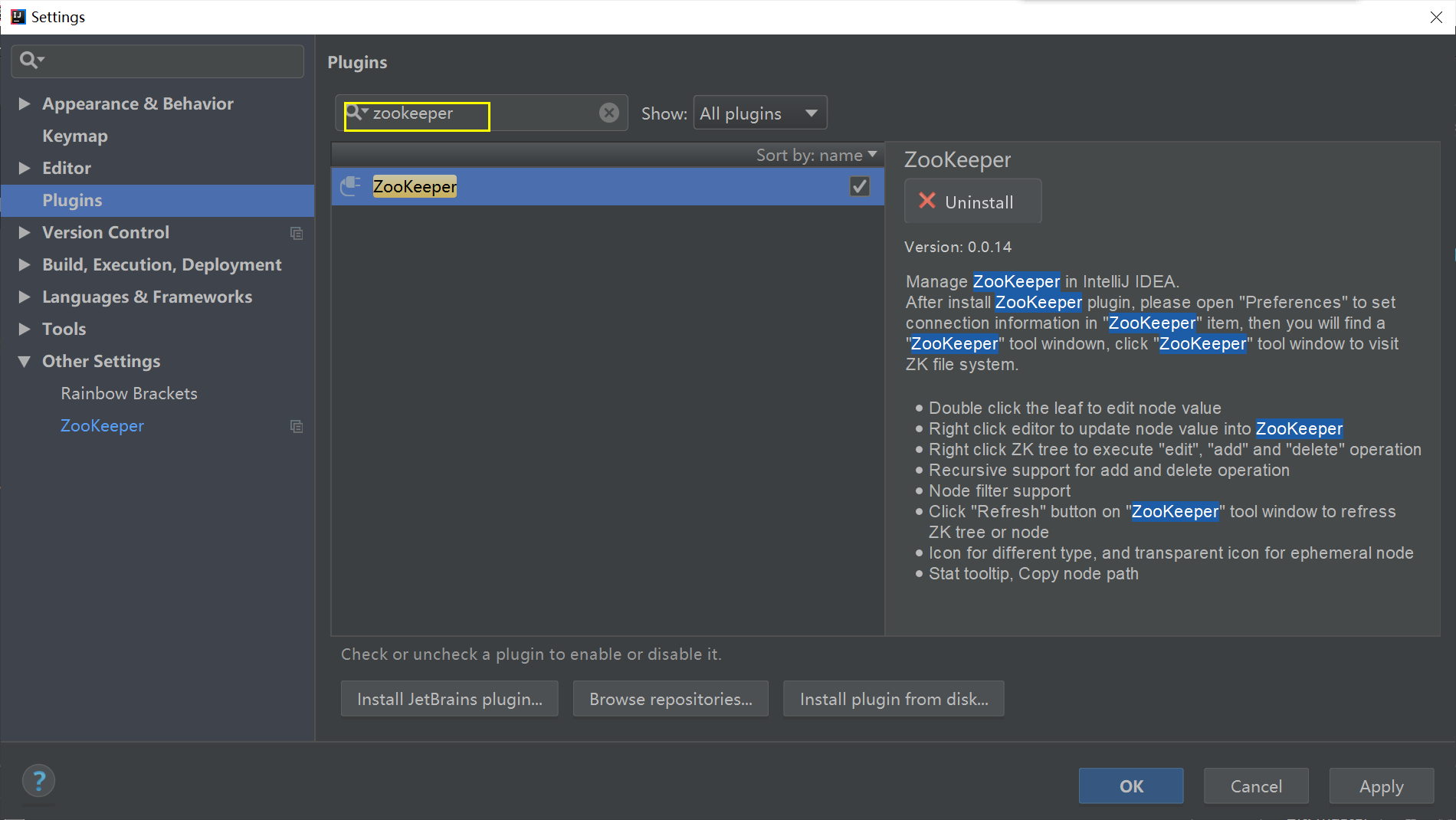
2、启动集群
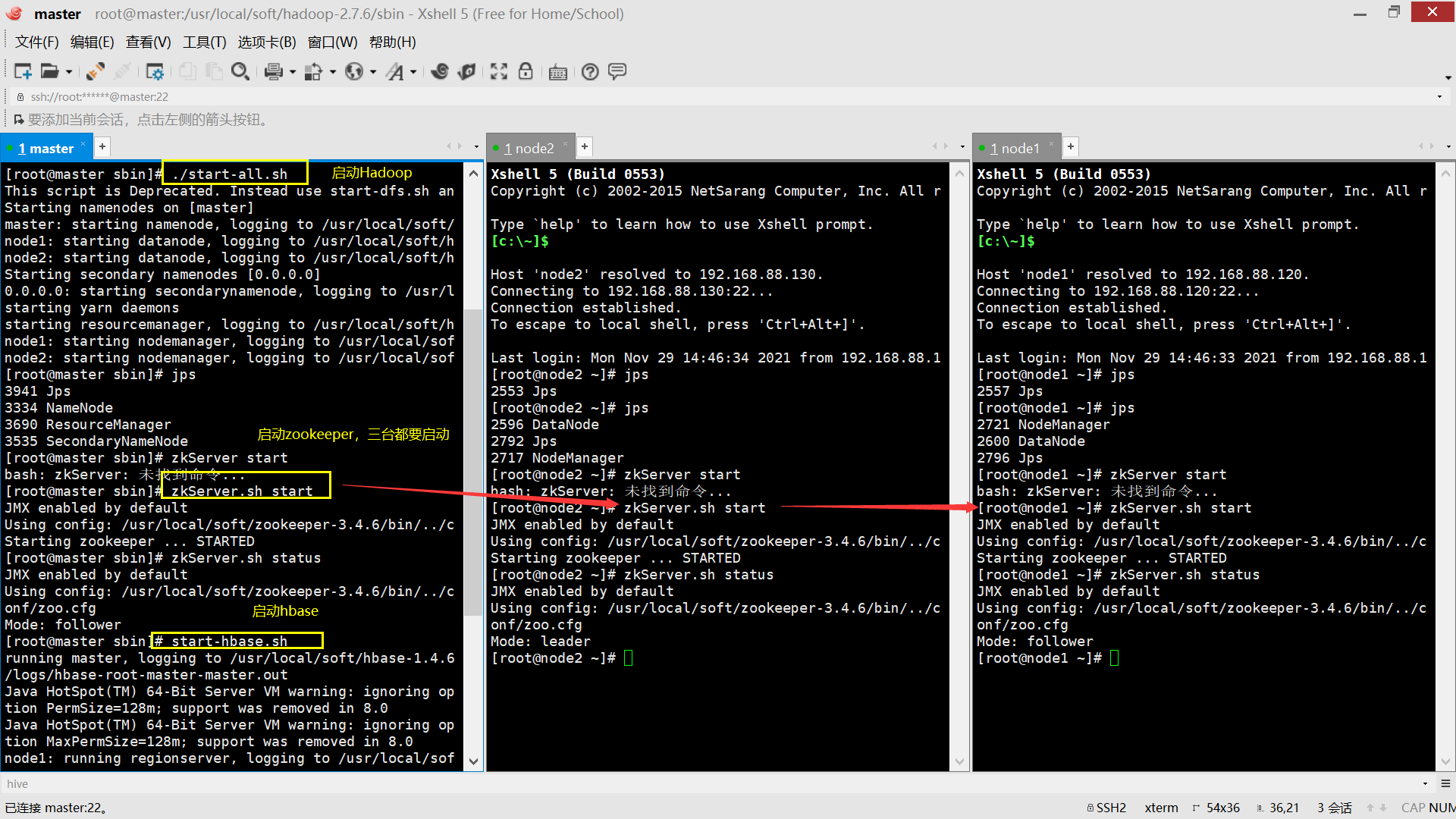
3、开始使用查看
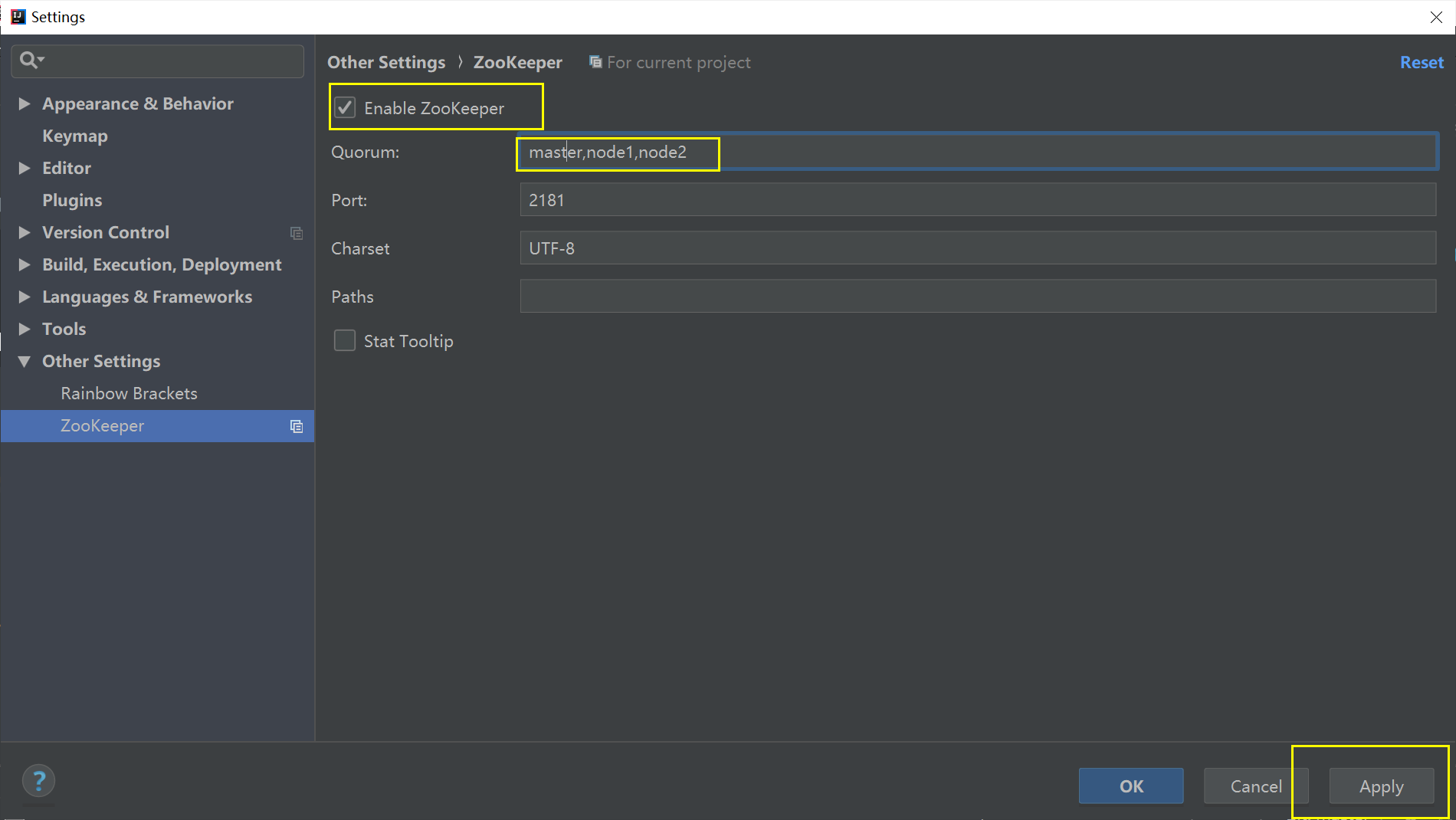
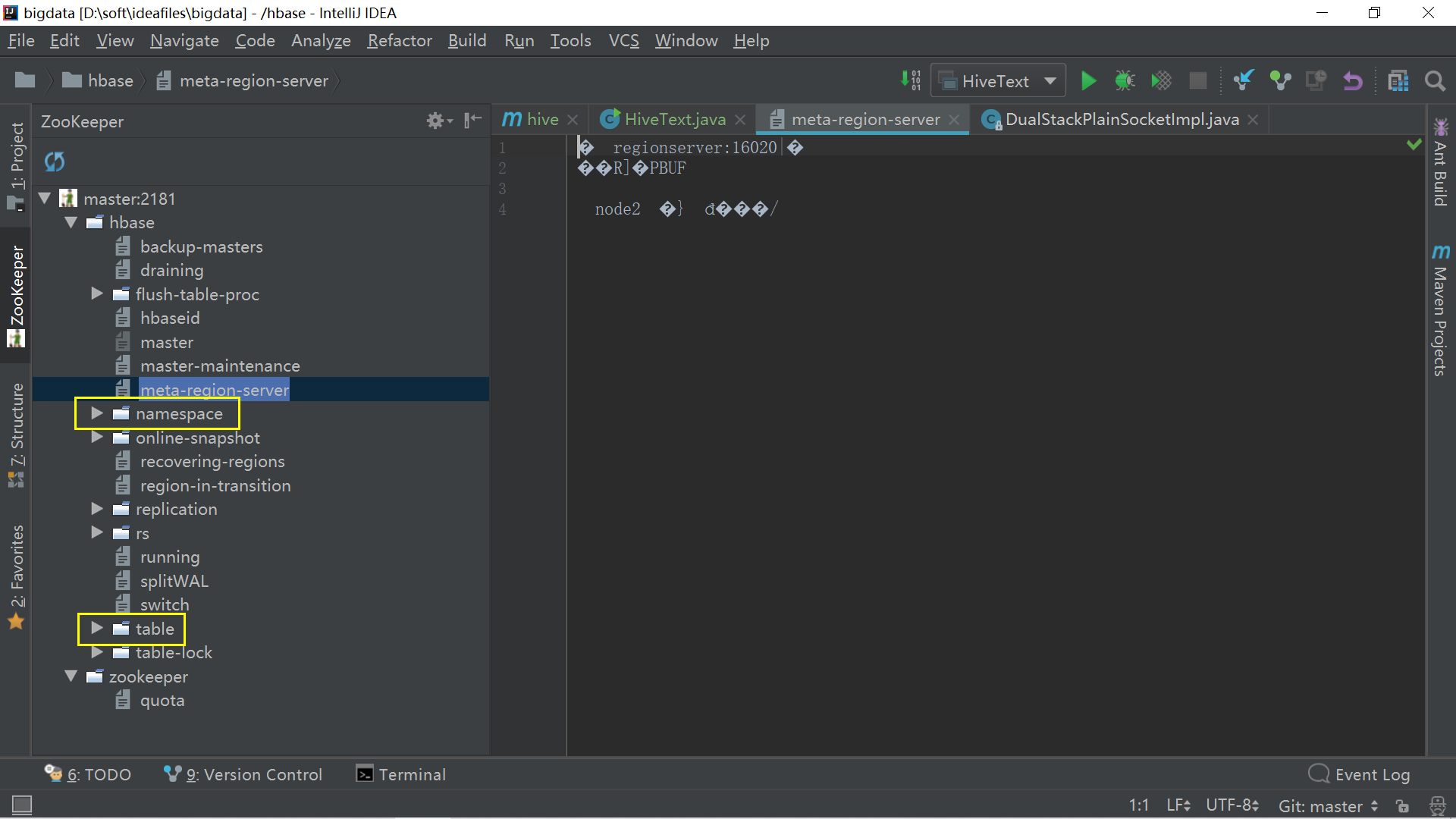
二、Hbase Java api
1、新建maven项目命名hbase

2、hbase项目pom文件导包
<dependencies>
<dependency>
<groupId>org.apache.hbase</groupId>
<artifactId>hbase-client</artifactId>
<version>1.4.6</version>
</dependency>
<dependency>
<groupId>junit</groupId>
<artifactId>junit</artifactId>
<version>4.8.2</version>
</dependency>
</dependencies>
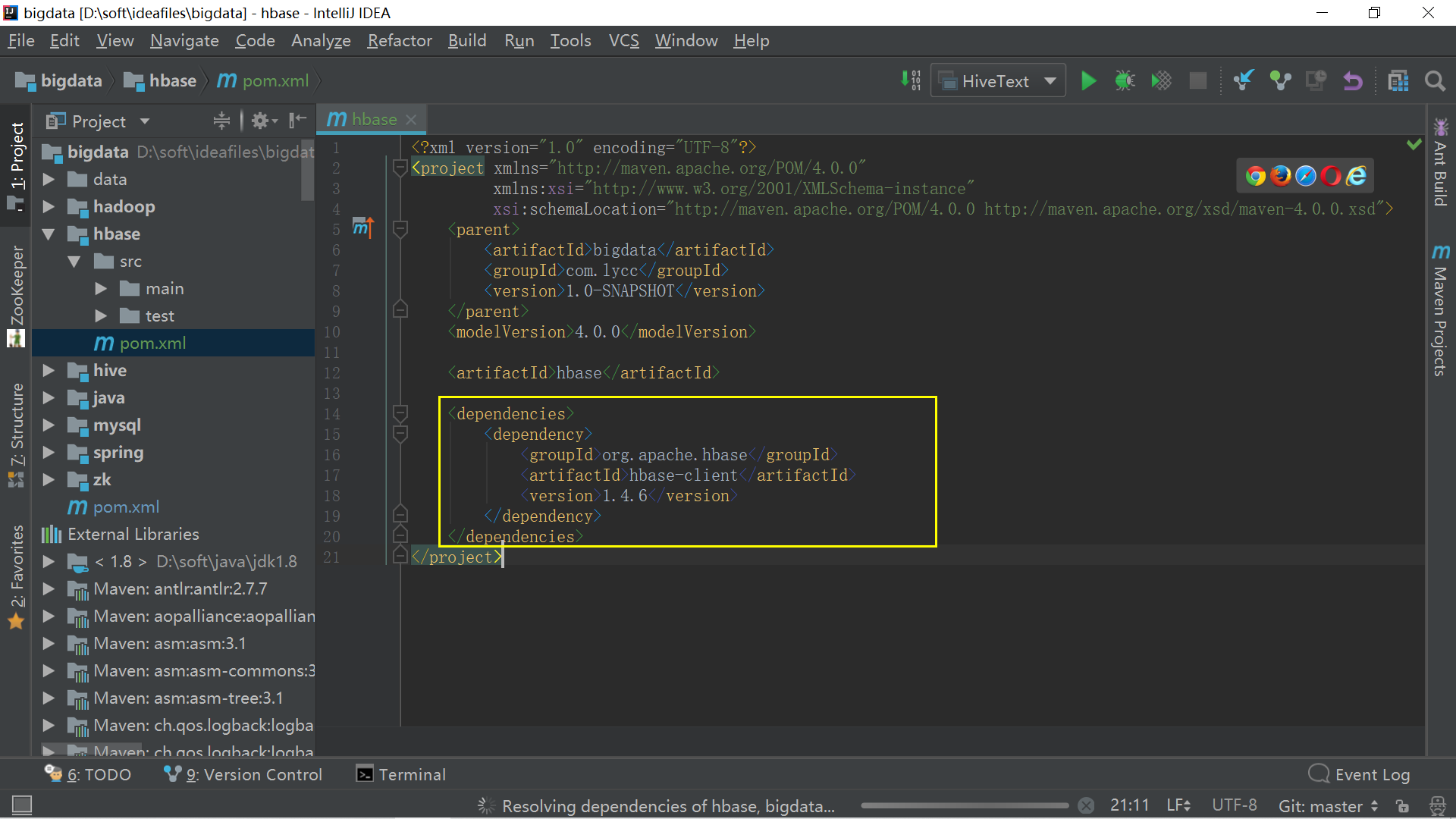
3、与hbase创建连接实现建表
import org.apache.hadoop.conf.Configuration;
import org.apache.hadoop.hbase.HBaseConfiguration;
import org.apache.hadoop.hbase.HColumnDescriptor;
import org.apache.hadoop.hbase.HTableDescriptor;
import org.apache.hadoop.hbase.TableName;
import org.apache.hadoop.hbase.client.Admin;
import org.apache.hadoop.hbase.client.Connection;
import org.apache.hadoop.hbase.client.ConnectionFactory;
import java.io.IOException;
public class APIDemo1 {
public static void main(String[] args) throws IOException {
//创建配置文件
Configuration conf = HBaseConfiguration.create();
//配置zk地址,通过zk可以找到hbase
conf.set("hbase.zookeeper.quorum","master:2181,node1:2181,node2:2181");
//创建连接
Connection conn = ConnectionFactory.createConnection(conf);
/**
* 操作表getAdmin
*/
Admin admin = conn.getAdmin();
//创建textAPI表,并指定列簇cf1,并将列簇的版本设置为3
HTableDescriptor textAPI = new HTableDescriptor(TableName.valueOf("textAPI"));
//创建一个列簇
HColumnDescriptor cf1 = new HColumnDescriptor("cf1");
//给列簇进行设置
cf1.setMaxVersions(3);
//给textAPI表增加一个列簇
textAPI.addFamily(cf1);
//创建表
admin.createTable(textAPI);
/**
* 操作数据getTable
*/
//关闭连接
admin.close();
conn.close();
}
}
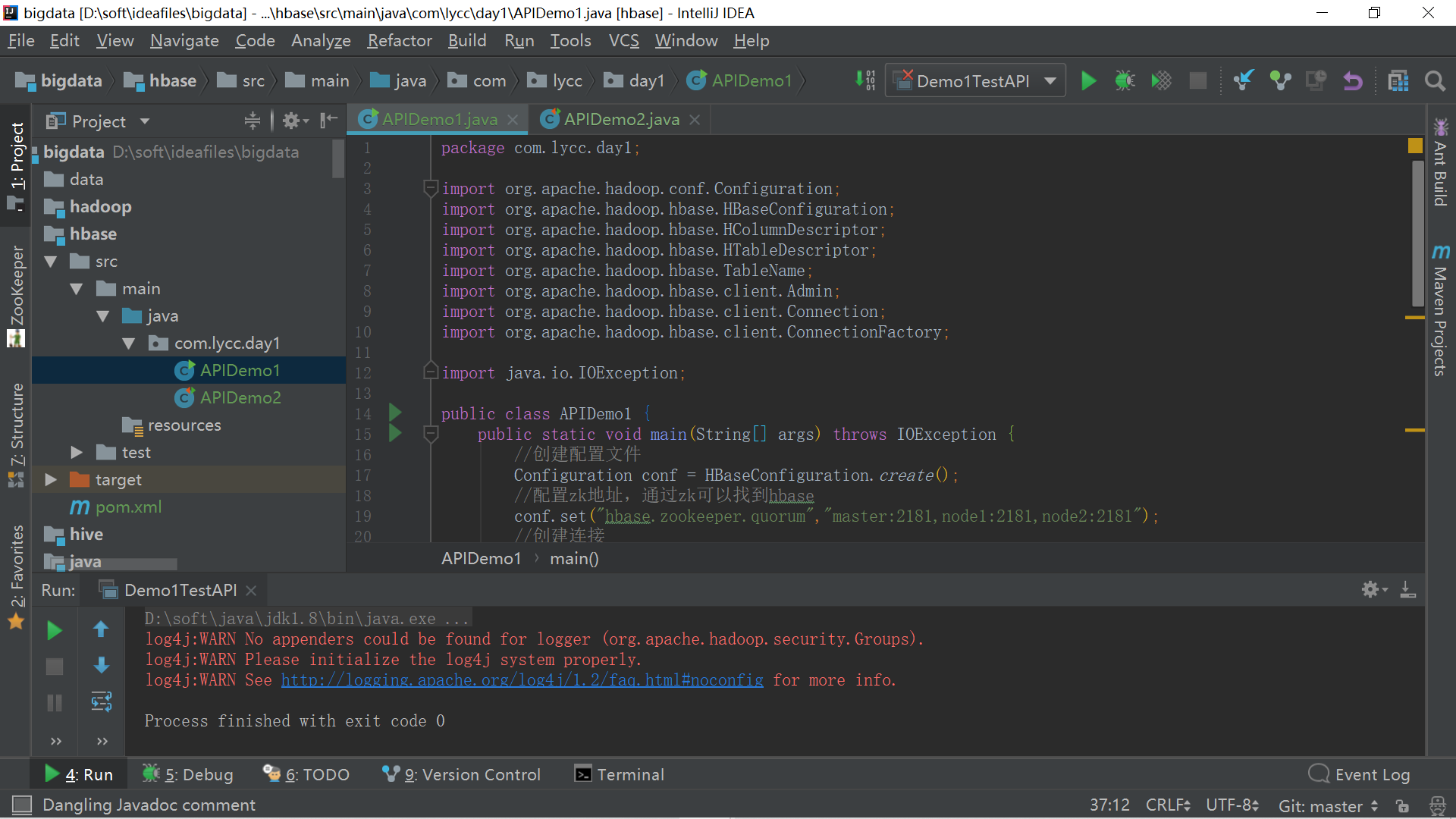
三、Java API操作hbase
getadmin对表操作
import org.apache.hadoop.conf.Configuration;
import org.apache.hadoop.hbase.HBaseConfiguration;
import org.apache.hadoop.hbase.HColumnDescriptor;
import org.apache.hadoop.hbase.HTableDescriptor;
import org.apache.hadoop.hbase.TableName;
import org.apache.hadoop.hbase.client.Admin;
import org.apache.hadoop.hbase.client.Connection;
import org.apache.hadoop.hbase.client.ConnectionFactory;
import org.junit.After;
import org.junit.Before;
import org.junit.Test;
import java.io.IOException;
public class APIDemo2 {
Connection conn;
Admin admin;
@Before
public void createConn() throws IOException {
//创建配置文件
Configuration conf = HBaseConfiguration.create();
//配置zk地址
conf.set("hbase.zookeeper.quorum","master:2181,node1:2181,node2:2181");
//创建连接
conn= ConnectionFactory.createConnection(conf);
//创建admin对象
admin = conn.getAdmin();
}
@Test
/**
*list
*/
public void list() throws IOException {
TableName[] tableNames = admin.listTableNames();
for (TableName tableName : tableNames) {
System.out.println(tableName.getNameAsString());
}
}
@Test
/**
* create table 建表
*/
public void createTable() throws IOException {
HTableDescriptor text = new HTableDescriptor(TableName.valueOf("text"));
HColumnDescriptor info = new HColumnDescriptor("info");
text.addFamily(info);
admin.createTable(text);
}
@Test
/**
* drop table删表
*/
public void dropTable() throws IOException {
//创建需要删除表对象
TableName text = TableName.valueOf("text");
//判断是否存在
if (admin.tableExists(text)){
admin.disableTableAsync(text);
admin.deleteTable(text);
}
}
@Test
/**
* 修改表结构
* 针对test表 将其info列簇的ttl设置为10000,并增加一个新的列簇cf1
*/
public void modifyTable() throws IOException {
TableName textAPI = TableName.valueOf("text");
//获取表原有的结构
HTableDescriptor tableDescriptor = admin.getTableDescriptor(textAPI);
//在表原有的结构上修改簇的属性
HColumnDescriptor[] columnFamilies = tableDescriptor.getColumnFamilies();
//遍历表中原有的列簇
for (HColumnDescriptor columnFamily : columnFamilies) {
//对原有的info列簇进行修改
if ("info".equals(columnFamily.getNameAsString())){
columnFamily.setTimeToLive(10000);
}
}
HColumnDescriptor cf1 = new HColumnDescriptor("cf1");
tableDescriptor.addFamily(cf1);
admin.modifyTable(textAPI,tableDescriptor);
}
@After
/**
* 关闭资源
*/
public void close() throws IOException {
admin.close();
conn.close();
}
}
getTable对表数据操作
import org.apache.hadoop.conf.Configuration;
import org.apache.hadoop.hbase.*;
import org.apache.hadoop.hbase.client.*;
import org.apache.hadoop.hbase.util.Bytes;
import org.junit.After;
import org.junit.Before;
import org.junit.Test;
import java.io.BufferedReader;
import java.io.FileReader;
import java.io.IOException;
import java.util.ArrayList;
import java.util.List;
public class Demo2API {
Connection conn;
Admin admin;
@Before
public void createConn() throws IOException {
// 1、创建一个配置文件
Configuration conf = HBaseConfiguration.create();
// 配置ZK的地址,通过ZK可以找到HBase
conf.set("hbase.zookeeper.quorum", "master:2181,node1:2181,node2:2181");
// 2、创建连接
conn = ConnectionFactory.createConnection(conf);
// 3、创建Admin对象
admin = conn.getAdmin();
}
@Test
/**
* put 插入一条数据
*/
public void put() throws IOException {
Table testAPI = conn.getTable(TableName.valueOf("testAPI"));
Put put = new Put("0002".getBytes());
// 相当于插入一列(一个cell)数据
put.addColumn("cf1".getBytes(), "name".getBytes(), "李四".getBytes());
put.addColumn("cf1".getBytes(), "age".getBytes(), "23".getBytes());
put.addColumn("cf1".getBytes(), "phone".getBytes(), "18888887".getBytes());
testAPI.put(put);
}
@Test
/**
* get 根据rowkey获取一条数据
*/
public void get() throws IOException {
Table testAPI = conn.getTable(TableName.valueOf("testAPI"));
Get get = new Get("0002".getBytes());
Result rs = testAPI.get(get);
// 获取rk
byte[] rk = rs.getRow();
System.out.println(rk);
System.out.println(Bytes.toString(rk));
// 获取cell
byte[] name = rs.getValue("cf1".getBytes(), "name".getBytes());
System.out.println(name);
System.out.println(Bytes.toString(name));
}
@Test
/**
* delete 删除数据
*/
public void deleteLine() throws IOException {
Delete delete = new Delete("1500100001".getBytes());
Table student = conn.getTable(TableName.valueOf("student"));
student.delete(delete);
}
@Test
/**
* putAll 读取学生信息数据并写入HBase的student表
*/
public void putAll() throws IOException {
/**
* 读取学生信息数据
*/
// Junit 和 main方法运行时的工作路径不一样
// 这里传入的相对路径要动态调整
BufferedReader br = new BufferedReader(new FileReader("data/students.txt"));
// 与HBase中的student表建立连接
Table student = conn.getTable(TableName.valueOf("split_table_test"));
String line = null;
// 创建Put的集合
ArrayList<Put> puts = new ArrayList<>();
int batchSize = 11;
while ((line = br.readLine()) != null) {
// 写入HBase
String[] splits = line.split(",");
String id = splits[0];
String name = splits[1];
String age = splits[2];
String gender = splits[3];
String clazz = splits[4];
Put put = new Put(id.getBytes());
byte[] info = "cf".getBytes();
put.addColumn(info, "name".getBytes(), name.getBytes());
put.addColumn(info, "age".getBytes(), age.getBytes());
put.addColumn(info, "gender".getBytes(), gender.getBytes());
put.addColumn(info, "clazz".getBytes(), clazz.getBytes());
// 每条数据都会执行一次,效率很慢
// student.put(put);
// 将每个Put对象加入puts集合
puts.add(put);
// 当puts集合的大小同batchSize大小一致时,则调用HTable的put方法进行批量写入
if (puts.size() == batchSize) {
student.put(puts);
// 清空集合
puts.clear();
}
}
System.out.println(puts.isEmpty());
System.out.println(puts.size());
// 当batchSize的大小同数据的条数不成整比的时候 可能会造成最后几条数据未被写入
// 手动去判断puts集合是否为空,不为空则将其写入HBase
if (!puts.isEmpty()) {
student.put(puts);
}
br.close();
}
@Test
/**
* scan 获取一组数据
* 读取student表
*/
public void getScan() throws IOException {
Table student = conn.getTable(TableName.valueOf("student"));
// scan可以指定rowkey的范围进行查询,或者是限制返回的条数
Scan scan = new Scan();
scan.withStartRow("1500100100".getBytes());
scan.withStopRow("1500100111".getBytes());
scan.setLimit(10);
for (Result rs : student.getScanner(scan)) {
String id = Bytes.toString(rs.getRow());
String name = Bytes.toString(rs.getValue("info".getBytes(), "name".getBytes()));
String age = Bytes.toString(rs.getValue("info".getBytes(), "age".getBytes()));
String gender = Bytes.toString(rs.getValue("info".getBytes(), "gender".getBytes()));
String clazz = Bytes.toString(rs.getValue("info".getBytes(), "clazz".getBytes()));
System.out.println(id + "," + name + "," + age + "," + gender + "," + clazz);
}
}
@Test
/**
* CellUtil
*/
public void scanWithCellUtil() throws IOException {
Table student = conn.getTable(TableName.valueOf("student"));
// scan可以指定rowkey的范围进行查询,或者是限制返回的条数
Scan scan = new Scan();
scan.withStartRow("1500100990".getBytes());
// scan.withStopRow("1500100111".getBytes());
for (Result rs : student.getScanner(scan)) {
String id = Bytes.toString(rs.getRow());
System.out.print(id + " ");
// 将一条数据的所有的cell列举出来
// 使用CellUtil从每一个cell中取出数据
// 不需要考虑每条数据的结构
List<Cell> cells = rs.listCells();
for (Cell cell : cells) {
String value = Bytes.toString(CellUtil.cloneValue(cell));
System.out.print(value + " ");
}
System.out.println();
}
}
@After
public void close() throws IOException {
admin.close();
conn.close();
}
}
四、HBase BulkLoading
优点
- 如果我们一次性入库hbase巨量数据,处理速度慢不说,还特别占用Region资源, 一个比较高效便捷的方法就是使用 “Bulk Loading”方法,即HBase提供的HFileOutputFormat类。
- 它是利用hbase的数据信息按照特定格式存储在hdfs内这一原理,直接生成这种hdfs内存储的数据格式文件,然后上传至合适位置,即完成巨量数据快速入库的办法。配合mapreduce完成,高效便捷,而且不占用region资源,增添负载。
限制
- 仅适合初次数据导入,即表内数据为空,或者每次入库表内都无数据的情况。
- HBase集群与Hadoop集群为同一集群,即HBase所基于的HDFS为生成HFile的MR的集群
代码
package com.shujia;
import org.apache.hadoop.conf.Configuration;
import org.apache.hadoop.fs.Path;
import org.apache.hadoop.hbase.HBaseConfiguration;
import org.apache.hadoop.hbase.KeyValue;
import org.apache.hadoop.hbase.TableName;
import org.apache.hadoop.hbase.client.Connection;
import org.apache.hadoop.hbase.client.ConnectionFactory;
import org.apache.hadoop.hbase.client.RegionLocator;
import org.apache.hadoop.hbase.client.Table;
import org.apache.hadoop.hbase.io.ImmutableBytesWritable;
import org.apache.hadoop.hbase.mapreduce.HFileOutputFormat2;
import org.apache.hadoop.hbase.mapreduce.KeyValueSortReducer;
import org.apache.hadoop.hbase.mapreduce.LoadIncrementalHFiles;
import org.apache.hadoop.hbase.mapreduce.SimpleTotalOrderPartitioner;
import org.apache.hadoop.io.LongWritable;
import org.apache.hadoop.io.Text;
import org.apache.hadoop.mapreduce.Job;
import org.apache.hadoop.mapreduce.Mapper;
import org.apache.hadoop.mapreduce.lib.input.FileInputFormat;
import org.apache.hadoop.mapreduce.lib.output.FileOutputFormat;
import java.io.IOException;
public class Demo10BulkLoading {
public static class BulkLoadingMapper extends Mapper<LongWritable, Text, ImmutableBytesWritable, KeyValue> {
@Override
protected void map(LongWritable key, Text value, Context context) throws IOException, InterruptedException {
String[] splits = value.toString().split(",");
String mdn = splits[0];
String start_time = splits[1];
// 经度
String longitude = splits[4];
// 维度
String latitude = splits[5];
String rowkey = mdn + "_" + start_time;
KeyValue lg = new KeyValue(rowkey.getBytes(), "info".getBytes(), "lg".getBytes(), longitude.getBytes());
KeyValue lt = new KeyValue(rowkey.getBytes(), "info".getBytes(), "lt".getBytes(), latitude.getBytes());
context.write(new ImmutableBytesWritable(rowkey.getBytes()), lg);
context.write(new ImmutableBytesWritable(rowkey.getBytes()), lt);
}
}
public static void main(String[] args) throws Exception {
Configuration conf = HBaseConfiguration.create();
conf.set("hbase.zookeeper.quorum", "master:2181,node1:2181,node2:2181");
// 创建Job实例
Job job = Job.getInstance(conf);
job.setJarByClass(Demo10BulkLoading.class);
job.setJobName("Demo10BulkLoading");
// 保证全局有序
job.setPartitionerClass(SimpleTotalOrderPartitioner.class);
// 设置reduce个数
job.setNumReduceTasks(4);
// 配置map任务
job.setMapperClass(BulkLoadingMapper.class);
// 配置reduce任务
// KeyValueSortReducer 保证在每个Reduce有序
job.setReducerClass(KeyValueSortReducer.class);
// 输入输出路径
FileInputFormat.addInputPath(job, new Path("/data/DIANXIN/"));
FileOutputFormat.setOutputPath(job, new Path("/data/hfile"));
// 创建HBase连接
Connection conn = ConnectionFactory.createConnection(conf);
// create 'dianxin_bulk','info'
// 获取dianxin_bulk 表
Table dianxin_bulk = conn.getTable(TableName.valueOf("dianxin_bulk"));
// 获取dianxin_bulk 表 region定位器
RegionLocator regionLocator = conn.getRegionLocator(TableName.valueOf("dianxin_bulk"));
// 使用HFileOutputFormat2将输出的数据按照HFile的形式格式化
HFileOutputFormat2.configureIncrementalLoad(job, dianxin_bulk, regionLocator);
// 等到MapReduce任务执行完成
job.waitForCompletion(true);
// 加载HFile到 dianxin_bulk 中
LoadIncrementalHFiles load = new LoadIncrementalHFiles(conf);
load.doBulkLoad(new Path("/data/hfile"), conn.getAdmin(), dianxin_bulk, regionLocator);
/**
* create 'dianxin_bulk','info'
* hadoop jar HBaseJavaAPI10-1.0-jar-with-dependencies.jar com.shujia.Demo10BulkLoading
*/
}
}
说明
- 最终输出结果,无论是map还是reduce,输出部分key和value的类型必须是: < ImmutableBytesWritable, KeyValue>或者< ImmutableBytesWritable, Put>。
- 最终输出部分,Value类型是KeyValue 或Put,对应的Sorter分别是KeyValueSortReducer或PutSortReducer。
- MR例子中HFileOutputFormat2.configureIncrementalLoad(job, dianxin_bulk, regionLocator);自动对job进行配置。SimpleTotalOrderPartitioner是需要先对key进行整体排序,然后划分到每个reduce中,保证每一个reducer中的的key最小最大值区间范围,是不会有交集的。因为入库到HBase的时候,作为一个整体的Region,key是绝对有序的。
- MR例子中最后生成HFile存储在HDFS上,输出路径下的子目录是各个列族。如果对HFile进行入库HBase,相当于move HFile到HBase的Region中,HFile子目录的列族内容没有了,但不能直接使用mv命令移动,因为直接移动不能更新HBase的元数据。
- HFile入库到HBase通过HBase中 LoadIncrementalHFiles的doBulkLoad方法,对生成的HFile文件入库






 浙公网安备 33010602011771号
浙公网安备 33010602011771号